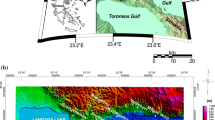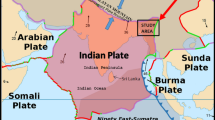Abstract
In the Barramiya area, the majority of gold deposits are generally related with the quartz veins that associated with shear zones cutting the crystalline basement rocks. The quartz vein system is controlled by shear zone and general faults. The present study is to delineate the general faults, shear zones, geological limits, and basement rock relief, using airborne magnetic and gravity data analysis at the Barramiya gold mine and surrounding area, Eastern Desert of Egypt. To achieve our goal, we have applied on magnetic and gravity data the following techniques: reduction to pole (RTP), analytical signal, tilt derivative, total horizontal derivative, 3D Euler deconvolution, downward continuation, and source parameter imagining power spectrum techniques. The analytical signal used to map the types of rock boundaries. Tilt derivative and total horizontal derivative filters helped to delineate fractures and the contact zones of the formations that host the main Barramiya shear zone. 3D Euler deconvolution techniques helped to delineate the fault trends which represented at the following direction: NNE–SSW and NNW–SSE. The average depths of both regional and residual causes have been estimated by applying downward continuation, source parameter imagining, and power spectrum techniques. According to the results of the present study, the depth of the basement rocks is relatively high (~ 80-m depth) in the western part of the study area and the basement rocks cropped out in the surface at the rest of the area. Our results are coinciding with the previous geological studies.















Similar content being viewed by others
References
Aero Service (1984) Final operational report of airborne magnetic/radiation survey in the Eastern Desert, Egypt, for the Egyptian General Petroleum Corporation, Aero Service Division, Houston, Texas, Six Volumes, Western Geophysical Company of America
Blakely RJ (1995) Potential theory in gravity and magnetic applications. Cambridge University Press, Cambridge
Botros NS (1993a) The possible occurrence of placer gold in areas lacking quartz veins in Egypt. J Geochemical Exploration 49(3):287–290
Botros NS (1993b) New prospects for gold mineralization in Egypt. Annals of Geological Survey Egypt 19:47–56
Botros NS (2004) A new classification of the gold deposits of Egypt. Ore Geol Rev 25:1–37
Boyd D (1969) The contribution of airborne magnetic surveys to geological mapping. In: Mining and Ground Water Geophysics. Geological Survey Of Canada, Economic Geology Report No. 26. pp 213–227
Clark DA (1997) Magnetic petrophysics and magnetic petrology: aids to geological interpretation of magnetic surveys. AGSO J Aust Geol Geophys 17:83–103
Cox SF, Etheridge MA, Wall VJ (1987) The role of fluids in syntectonic mass transport, and the localization of metamorphic vein-type ore deposits. Ore Geol Rev 2:65–86
EGPC (Egyptian General Petroleum Corporation) (1983) Aeromagnetic survey of north Eastern Desert and Gulf of Suez, by Western Geophysical Company of America
EGSMA (1992) Geological map of Wadi El Barramiya Quadrangle, Egypt, scale 1:250, 000 Geological Survey of Egypt
Egyptian Geological Survey (EGS) (1978) Results of prospecting evaluation carried out at the Eastern flank of the Barramiya gold ore deposit in 1976–1977. Internal report No. 16/78, Documentation center of the Geology Survey of Egypt
El Ramly MF, Ivaanov SS, Kochin GC (1970) The occurrence of gold in the Eastern Desert of Egypt. Studies on Some Mineral Deposits of Egypt. Part I, Sec. A, Metallic Minerals. Geological Survey of Egypt 21:1–22
El-Dougdoug A (1990) Gold anomalies in the late Proterozoic felsic mafic volcano sedimentary sequence and associated rocks, Gebel Abu Marawat area, Eastern Desert, Egypt. Bulletin of the Faculty of Science, Cairo University 58:533–548
El-Mezayen AM, Hassaan MM, El-Hadad M, Hassanein MM (1995) Petrography, geochemistry and ore microscopy of Abu Marawat metavolcanics and associated gold mineralisation, North Eastern Desert, Egypt. Bulletin of the Faculty of Science, Al-Azhar Univeristy 6(2):1999–2021
El-Shazly EM (1977) The Geology of the Egyptian Region. In: Nairn AEM, Kanes WH, Stehli FG (eds) Geology of the Egyptian region: the ocean basins and margins, vol. 4A. Plenum Press, New York, pp 379–444
Gabra SZ (1986) Gold in Egypt. A commodity package: minerals, petroleum and groundwater assessment program. USAID project 363-0105. Geological Survey of Egypt. 86 pp
General Petroleum Corporation, A.S.R.T (1980) Bouguer gravity map of Egypt. Scale 1:500,000
Geosoft Oasis Montaj (2007) Mapping and application system Inc, Suite 500, Richmond St. West Toronto, ON Canada N5SIV6
Geosoft Oasis Montaje (2007) Version 6.2.4 for the Earth Science, Geosoft Inc, Toronto, Canada
Grant FS, West GF (1965) Interpretation theoryin applied geophysics, McGraw-Hill Book Company, New York
Grauch VJS, Milligan PS (1998) Mapping intrabasinal faults from high-resolution aeromagnetic data. Leading Edge 17:53–55
Green R, Stanly JM (1975) Application of a Hilbert transform method to the interpretation of surface-vehicle magnetic data. Geophysical Prospecting 32(1):18–27
Halls C, Zhao R (1995) Listvenite and related rocks: perspectives on terminology and mineralogy with reference to an occurrence at Cregganbaun, Co. Mayo, Republic of Ireland. Mineral Deposita 30:303–313
Hartman RR, Teskey DJ, Friedberg JL (1971) A system for rapid digital aeromagnetic interpretation. Geophysics 36:891–918
Hassaan MM, El Mezayen AM, Dardir AA, Hassanein MM (1996) Primary distribution pattern of gold and associated elements in Abu Marawat mine, North Eastern desert and significance to exploration. Al Azhar Bulletin of Science 7:995–1016
Hassaan MM, Ramadan TM, Abu El Leil I, Sakr SM (2009) Lithochemical surveys for ore metals in arid region, Central Eastern Desert, Egypt: using Landsat ETM+ imagery. Aust J Basic Appl Sci 3:512–528
Henderson RG, Zietz I (1949) The upward continuation of anomalies in total magnetic intensity fields. Geophysics 14:517–534
Hsu SK (2002) Imaging magnetic sources using Euler’s equation. Geophys Prospect 56:15–25
Hume WF (1937) Geology of Egypt, V.II, part III. Geological Survey of Egypt
Keating PB (1995) A simple technique to identify magnetic anomalies due to kimberlite pipes. Explor Min Geol 4:121–125
Kochine GG and Bassuni FA (1968) Mineral resources of the U.A.R.: part I. metallic minerals. Interact. Report Geological Survey of Egypt, pp. 305-436
Macleod IN, Jones K, Dai TF (1993) 3-D analytic signal in the interpretation of the total magnetic field data at low magnetic latitudes. Explor Geophys 24:679–688
Marten BE (1986) Reconnaissance of gold deposits, Eastern Desert, Egypt. Parts I and II. Minerals International Ltd, Exploration Department, New Bury, pp 1–44
Miller HG, Singh V (1994a) Potential field tilt—a new concept for location of potential field sources. J Appl Geophys 32:213–217
Miller HG, Singh V (1994b) Potential field tilt a new concept for location of potential sources. Appl Geophys 32:213–217
Nabighian MN (1972) The analytic signal of two-dimensional magnetic bodies with polygonal cross-sections; its properties and use for automated anomaly interpretation. Geophysics 37:507–517
NSPT Software (1984) Compatibility software GW-Basic, Version 2.02, by Phoenix software associated Ravat DN, Langel RA, Purucker M, Arkani-Hamid J, Alsdorf DE (1995) Global vector and scalar Magsat magnetic anomaly maps. J Geophysics Res 100:20111–20136
Osman A (1995) The mode of occurrence of gold-bearing listvenite at El Barramiya gold mine, Eastern desert, Egypt. Middle East Research Centre. Ain Shams University. Earth Sciences Series 9:93–103
Osman A (2001) The gold metallotect in the Eastern Desert of Egypt. In: Piestrzyhski, et al. (Ed.), Mineral Deposits at the Beginning of the 21st Century, Swets & Zeitinger, Lisse, pp 795–798
Ramadan TM (2002) Exploration for gold-bearing listwaenites at Um Khasila area, Central Eastern Desert, Egypt. Egyptian Journal of Remote Sensing and Space Sciences 5:63–76
Ramadan TM, Sadek MF, Abu El Leil I, Salem SM (2005) Um El Touyur El Fuqani gold mineralization, South Eastern Desert, Egypt: using Landsat ETM+ imagery. Annals of Geological Survey of Egypt 28:263–281
Reid AB, Allsop JM, Granser H, Millett AJ, Somerton IW (1990) Magnetic interpretation in three dimensions using Euler deconvolution. Geophysics 55:80–91
Roest WR, Pilkington M (1993) Identifying remanent magnetization effects in magnetic data. Geophysics 58:653–659
Roest WR, Verhoef J, Pilkington M (1992) Magnetic interpretation using the 3-D analytic signal. Geophysics 57:116–125
Sabet AH, Bondonosov VP (1984) The gold ore formations in the Eastern Desert of Egypt. Ann Geol Surv Egypt 14:35–42
Sabet AH, Tscgoev VB, Bordonosov VP, Babourin LM, Zalata AA, Francis MH (1976) On gold mineralization in the eastern desert of Egypt. Annals of Geological Survey of Egypt 6:201–212
Salem A, Williams S, Fairhead JD, Ravat D, Smith R (2007) Tilt-depth method: a simple depth estimation method using first-order magnetic derivatives. The leading edge 26:1502–1505
Spector A, Grant FS (1970) Statistical models for interpreting aeromagnetic data. Geophysics 35:293–302
Stavrev PY (1997) Euler deconvolution using differential similarity transforms of gravity or magnetic anomalies. Geophys Prospect 45:207–246
Thompson DT (1982) EULDPH: a new technique for making computer assisted depth estimates from magnetic data. Geophysics 47:31–37
Thurston JB, Smith RS (1997) Automatic conversion of magnetic data to depth, dip and susceptibility contrast using the SPITM method. Geophysics 62:807–813
Verduzco BJD, Fairhead CM, Green, MacKenzie C (2004) New insights into magnetic derivatives for structural mapping. The leading edge 23:116–119
Werner RT (1953) Interpretation of magnetic anomalies at sheet-like bodies. Sveriges Geologiska Undersok, Series C. Arsbok 6:413–449
Youssef MI (1968) Structural pattern of Egypt and its interpretation. Am Assoc Pet Geol Bull 52:601–614
Acknowledgments
The author is grateful to Daniel Miggins (Oregon State University, USA) for his helpful review, and to thanks reviewers for their helpful reviews.
Author information
Authors and Affiliations
Corresponding author
Rights and permissions
About this article
Cite this article
Saleh, A., Abdelmoneim, M., Abdelrady, M. et al. Subsurface structural features of the basement complex and mineralization zone investigation in the Barramiya area, Eastern Desert of Egypt, using magnetic and gravity data analysis. Arab J Geosci 11, 676 (2018). https://doi.org/10.1007/s12517-018-3983-7
Received:
Accepted:
Published:
DOI: https://doi.org/10.1007/s12517-018-3983-7




